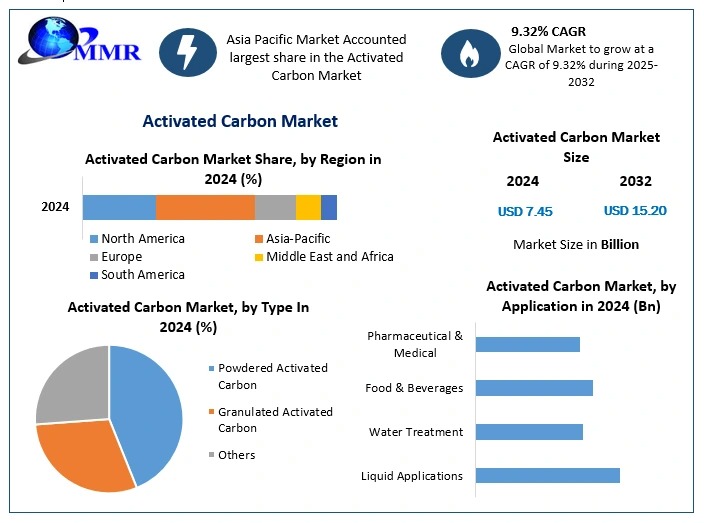Activated Carbon Market Size Projected to Reach USD 15.20 Billion by 2032
The Activated Carbon Market Size, valued at USD 7.45 billion in 2024, is anticipated to expand to approximately USD 15.20 billion by 2032, reflecting a compound annual growth rate (CAGR) of 9.32% during the forecast period. This growth is primarily driven by the increasing need for pollution control measures and the widespread adoption of activated carbon in water purification processes.
Market Definition and Overview
Activated carbon, also known as activated charcoal, is a form of carbon processed to have small, low-volume pores that increase the surface area available for adsorption or chemical reactions. Its high degree of microporosity makes it highly effective in capturing contaminants, leading to its extensive use in applications such as air and water purification, decaffeination, gold purification, metal extraction, sewage treatment, and medical therapies.
Curious about the market dynamics? Get a free sample to explore the latest insights here:https://www.maximizemarketresearch.com/request-sample/17449/
Key Growth Drivers and Opportunities
-
Escalating Demand for Pollution Control: The global increase in pollution levels has heightened the need for effective emission control solutions. Activated carbon’s exceptional adsorption capabilities make it a preferred choice for removing volatile organic compounds (VOCs), odors, and other gaseous pollutants from industrial emissions, thereby supporting environmental compliance efforts.
-
Advancements in Water Treatment Technologies: The growing emphasis on providing clean and safe drinking water has led to the adoption of advanced water treatment methods. Activated carbon is widely used in these processes to remove impurities, chlorine, and organic compounds, enhancing water quality and safety.
-
Regulatory Support for Emission Reduction: Governmental regulations worldwide are increasingly mandating the reduction of industrial emissions. For instance, the Environmental Protection Agency (EPA) has established Maximum Achievable Control Technology (MACT) standards, compelling industries to implement effective emission control technologies, thereby driving the demand for activated carbon.
-
Emerging Applications in Healthcare: Activated carbon’s detoxifying properties have led to its increased use in the pharmaceutical and healthcare industries. It is utilized in treatments for drug overdoses and poisonings, as well as in the development of medical devices and wound care products, presenting new growth avenues for the market.
Segmentation Analysis
The activated carbon market is segmented based on product type, application, and region.
By Product Type:
-
Powdered Activated Carbon (PAC): Known for its fine particle size, PAC is widely used in water treatment and air purification applications due to its high adsorption capacity.
-
Granular Activated Carbon (GAC): With larger particle sizes, GAC is preferred in applications such as water filtration and industrial processes, offering advantages in reactivation and reuse.
-
Extruded or Pelletized Activated Carbon: Formed into cylindrical shapes, this type is utilized in gas phase applications, including air treatment and solvent recovery, owing to its low-pressure drop and high mechanical strength.
By Application:
-
Water Treatment: Activated carbon is extensively used to remove contaminants and impurities from water, making it suitable for drinking water purification, wastewater treatment, and aquariums.
-
Air Purification: In air purification systems, activated carbon effectively adsorbs volatile organic compounds (VOCs), odors, and harmful gases, improving indoor and outdoor air quality.
-
Industrial Processes: Activated carbon plays a crucial role in various industrial applications, including solvent recovery, gold purification, and as catalysts in chemical reactions.
-
Food and Beverage Processing: Utilized in decolorization and purification processes, activated carbon helps in refining edible oils, sugars, and alcoholic beverages.
Regional Insights
Asia-Pacific: This region is expected to lead the activated carbon market during the forecast period, driven by rapid industrialization, urbanization, and stringent environmental regulations in countries like China and India. The increasing need for water and air purification solutions further propels market growth in this region.
North America: The North American market is characterized by a strong focus on environmental sustainability and stringent regulatory frameworks, leading to significant adoption of activated carbon in pollution control and water treatment applications.
Europe: Europe holds a substantial market share, with growing applications of activated carbon in industries such as food and beverage, pharmaceuticals, and automotive. The region’s commitment to environmental protection and sustainable practices supports the market’s expansion.
Competitive Landscape
The activated carbon market is competitive, with key players focusing on strategic initiatives such as mergers and acquisitions, capacity expansions, and technological innovations to strengthen their market position. Notable companies operating in the market include:
-
Osaka Gas Co. Ltd.: A leading provider of activated carbon products, offering solutions for water and air purification, as well as industrial applications.
-
Cabot Corporation: Specializes in the production of activated carbon for a variety of applications, emphasizing innovation and sustainability.
-
Kuraray Co. Ltd.: Offers a diverse range of activated carbon products, focusing on high-performance solutions for environmental and industrial applications.
-
Haycarb Plc: Renowned for its coconut shell-based activated carbon, serving industries such as water treatment, air purification, and gold recovery.
-
Kureha Corporation: Provides advanced activated carbon materials, catering to applications in energy storage, environmental protection, and healthcare.
Conclusion
The global activated carbon market is poised for significant growth, driven by increasing applications in pollution control, water purification, and emerging uses in the healthcare sector. As industries and consumers continue to prioritize environmental sustainability and health, the demand for activated carbon is expected to rise, offering substantial opportunities for market participants.
